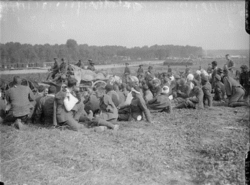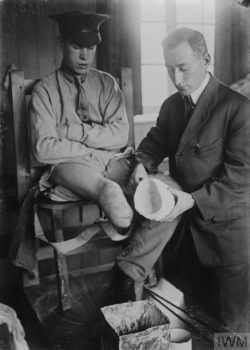Visible Disability
Thomas Barker, born in 1883 in Bishops Lydeard, Somerset, was a Private in the Somerset Light Infantry. He enlisted to serve in the army in November 1915. Whilst serving in the war, he, like many other men, suffered a serious injury which was to impact every aspect of his life.
Posted to France on 27 July 1917, it is likely that Thomas fought in the Battle of Arras, as this is the place of injury specified in his injury report. The Battle began as a British attack on German defences in the city, but it soon turned into a stalemate. Both sides suffered heavy casualties [Holmes, 2004]. Thomas was injured on the first day of the battle, 4 July 1917, whilst advancing with his company, when a shell burst near him wounding his left leg.

Wounded British troops outside a Casualty Clearing Station at Heilly, Somme, September 1916
In the first instance, Thomas was treated at a C.C.S – Casualty Clearing Station. This was the first well-equipped and static medical facility that wounded men would visit. It was often a tented camp, or huts if possible, and a typical C.C.S could hold 1,000 casualties at any time. Serious operations were carried out here. [Baker, 2009] It was at one of these stations where, 6 days after his injury, Thomas had his left leg amputated. He was admitted to hospital a further 6 times, and his leg was amputated a total of three times. About one and a half inches of his tibia was sawn off, and his wound was sutured. On his return to England, he was admitted to the Queen Mary Convalescent Auxiliary Hospital, a place of rehabilitation for servicemen who had lost limbs during the war service. Towards the end of his treatment, in 1919, Thomas was given an artificial limb.

A doctor takes a plaster cast of the remainder of an amputee's right leg at Queen Mary's Hospital, Roehampton, Surrey, in preparation for fitting a specially made artificial limb. Copyright: © IWM. Original Source: http://www.iwm.org.uk/collections/item/object/205196749
Thomas’ file includes no explicit indication of how and to what extent the amputation affected his life, however, we can assume that the impact was significant. War was a masculine sphere, associated with strength, bravery and honour, and this mindset reached society back in England. Physically, this was emblemised as an able man; men, like Thomas, without limbs therefore did not fit this ideal because disability emasculated them in society’s eyes [Meyer, 2009].
Furthermore, physical disability made it even more difficult for soldiers to begin their transition back into civilian life. They were forced to adapt to their physical and emotional changes, find a suitable place within business or industry, as well as come to term with the loss of their pre-war hopes and expectations [Larsson, 2009].
There are few documents pertaining to the pensions Thomas received. The amount he received is not specified, only that he was awarded 60% disability which demonstrates the severity of his injury and the significant impact on his life.
Click on any of the words below to find out more
Amputated Tibia
Sutured Rehabilitation Artificial limb
Prosthetic Pneumonia GSW Malingering
Mutilation Disfiguration
Gallery
Useful links
If you would like to learn more about the prosthetics of First World War veterans take a look at these videos:
This website contains more information on Casualty Clearing Stations during the First World War:
